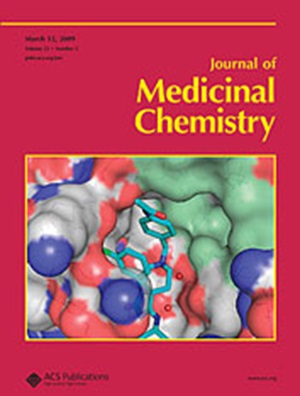99mtc标记的基于喹诺酮的新型骨骼示踪剂通过成纤维细胞激活蛋白可视化肿瘤
IF 6.8
1区 医学
Q1 CHEMISTRY, MEDICINAL
引用次数: 0
摘要
成纤维细胞活化蛋白(FAP)已成为肿瘤诊断的重要靶点。基于喹啉的FAP PET示踪剂证明了临床可行性。然而,99mtc标记的FAP SPECT示踪剂的临床研究相对缺乏。现有的喹啉衍生的99mTc-FAPI示踪剂具有较低的肿瘤摄取和不理想的药代动力学特性,限制了其临床应用。因此,有必要对药效团进行改造,以提高其药性。在这项研究中,利用支架跳跃和构象约束策略开发了一种新的喹诺酮类药效团。进行了系列筛选和临床前评估。99mTc-FAPI-YQ3具有极高的肿瘤摄取率和良好的药代动力学特性。此外,99mTc-FAPI-YQ3在4种不同肿瘤患者中表现出可靠的安全性和临床疗效。总之,99mTc-FAPI-YQ3是一种很有前景的fap靶向癌症诊断的放射性示踪剂,为大大推进SPECT分子成像提供了线索。本文章由计算机程序翻译,如有差异,请以英文原文为准。

99mTc-Labeled Quinolone-Based Novel Skeletal Tracers for Tumor Visualization through Fibroblast Activation Protein
Fibroblast activation protein (FAP) has emerged as a prominent target for tumor diagnosis. Quinoline-based FAP PET tracers demonstrated clinical feasibility. However, there is a relative scarcity of clinical studies on 99mTc-labeled FAP SPECT tracers. The existing quinoline-derived 99mTc-FAPI tracer exhibits relatively low tumor uptake and suboptimal pharmacokinetic properties, which restrict its clinical application. Consequently, it is necessary to alter the pharmacophores to improve its druggability. In this study, a novel quinolone-based pharmacophore was developed by utilizing scaffold hopping and conformational constrained strategies. Serial screening and preclinical evaluations were conducted. The 99mTc-FAPI-YQ3 showed extremely high tumor uptake and excellent pharmacokinetic properties. Additionally, 99mTc-FAPI-YQ3 demonstrated reliable safety characteristics and clinical efficacy on four different oncology patients. In conclusion, 99mTc-FAPI-YQ3 was a promising radiotracer for FAP-targeted cancer diagnosis, shedding light on substantially advancing SPECT molecular imaging.
求助全文
通过发布文献求助,成功后即可免费获取论文全文。
去求助
来源期刊

Journal of Medicinal Chemistry
医学-医药化学
CiteScore
4.00
自引率
11.00%
发文量
804
审稿时长
1.9 months
期刊介绍:
The Journal of Medicinal Chemistry is a prestigious biweekly peer-reviewed publication that focuses on the multifaceted field of medicinal chemistry. Since its inception in 1959 as the Journal of Medicinal and Pharmaceutical Chemistry, it has evolved to become a cornerstone in the dissemination of research findings related to the design, synthesis, and development of therapeutic agents.
The Journal of Medicinal Chemistry is recognized for its significant impact in the scientific community, as evidenced by its 2022 impact factor of 7.3. This metric reflects the journal's influence and the importance of its content in shaping the future of drug discovery and development. The journal serves as a vital resource for chemists, pharmacologists, and other researchers interested in the molecular mechanisms of drug action and the optimization of therapeutic compounds.
 求助内容:
求助内容: 应助结果提醒方式:
应助结果提醒方式:


